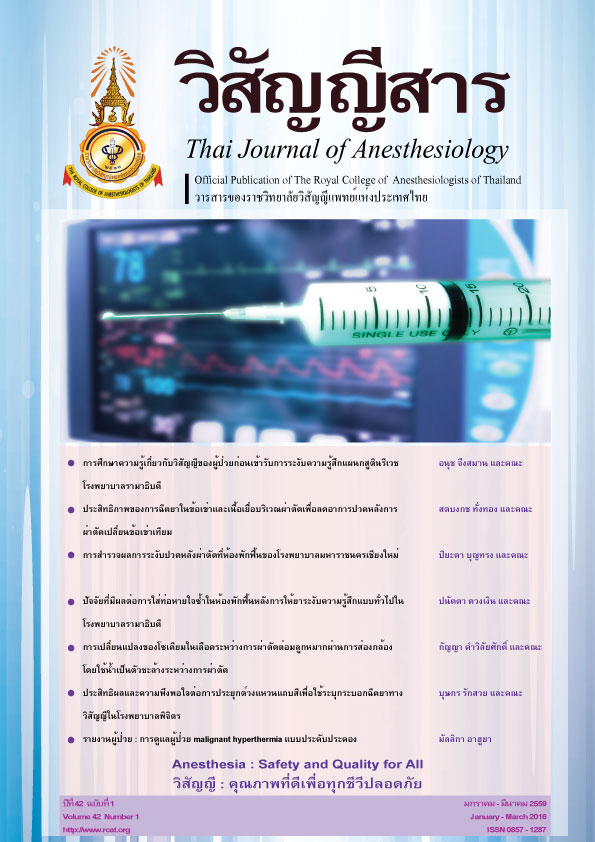The changes of plasma sodium level during transurethral resection of prostate procedure by using sterile water irrigation
Main Article Content
Abstract
Background: Fluid irrigation is necessary in transurethral resection of prostate (TUR-P) for clearance of blood clot and tissue during the operation. The absorption of fluid irrigation can induce hyponatremia and hemolysis. In this study, we observed the change of serum sodium levels and analyzed the risk factors for symptomatic hyponatremia.
Methods: Serum sodium levels were tested every 15 minutes since the operation start until 1 hour after operation finish in 42 patients. The relationship between serum sodium level changing and prostate size, the volume of sterile water irrigation and hemolysis were observed. Surgical time, body weight before and after operation were recorded. Blood samplings were collected via arterial line catheter. Serum osmolarities were calculated.
Results: Significant reductions of serum sodium levels were observed in 6 patients with symptoms. These were related with volume of water irrigating more than 15.2 liters (p value = 0.01), prostate size more than 26.33 grams (p value = 0.002), and surgical time longer than 65 minutes (p value = 0.001). We found correlation between volume of water irrigating and rising body weight (r= 0.844, p value < 001). Serum osmolarities level decreased significantly. No significant elevation of potassium or hemoglobin level.
Conclusion: Risk factors of TUR-P syndrome are large volume of sterile water irrigating, prostate size, and prolong surgical time. To weigh before and after sterile water irrigation is simple way to assessment fluid absorption indirectly. Sterile water irrigation does not cause hemolysis in this studied so it can be used safety in this procedure.
การเปลี่ยนแปลงของโซเดียมในเลือดระหว่างการผ่าตัดต่อมลูกหมากผ่านการส่องกล้องโดยใช้น้ำเป็นตัวชะล้างระหว่างการผ่าตัด
ที่มา: การผ่าตัดต่อมลูกหมากผ่านการส่องกล้อง ต้องใช้สารน้ำสำหรับชะล้างเลือดและชิ้นเนื้อเพื่อช่วย ให้ภาพชัดเจน การดูดซึมน้ำสำหรับชะล้างเข้าสู่ร่างกายส่งผลทำให้เกิดภาวะโซเดียมในเลือดต่ำและอาจก่อให้ เกิดภาวะเม็ดเลือดแดงแตก คณะผู้วิจัยจึงต้องการศึกษาการเปลี่ยนแปลงของโซเดียมในเลือดระหว่างการผ่าตัด รวมถึงหาปัจจัยเสี่ยงในการเกิดภาวะโซเดียมในเลือดต่ำแบบมีอาการ
วิธีการ: ทำการศึกษาในผู้ป่วย 42 ราย โดยเก็บข้อมูลความสัมพันธ์ระหว่างการเปลี่ยนแปลงของโซเดียมในเลือดกับปริมาณของน้ำที่ใช้ในการผ่าตัด ขนาดของต่อมลูกหมาก ระยะเวลาที่ผ่าตัด และน้ำหนักผู้ป่วยก่อนและหลังผ่าตัด โดยเก็บตัวอย่างเลือดของ ผู้ป่วยจากเส้นเลือดแดงทุก 15 นาทีตั้งแต่เริ่มผ่าตัด จนถึงหลังผ่าตัดเป็นเวลา 1 ชั่วโมงและคำนวณค่าความ เข้มข้นของสารละลายในเลือด
ผลการศึกษา: มีผู้ป่วยเกิดภาวะโซเดียมในเลือดต่ำแบบมีอาการจำนวน 6 ราย สัมพันธ์กับปริมาณน้ำที่ใช้ทำผ่าตัดมากกว่า 15.23 ลิตร (p value = 0.01) ต่อมลูกหมากขนาดใหญ่กว่า 26.33 กรัม (p value = 0.002) ระยะเวลาผ่าตัดนานกว่า 65 นาที (p value = 0.001) พบความสัมพันธ์แบบแปรผันตรงระหว่าง ปริมาณน้ำที่ใช้กับน้ำหนักตัวที่เพิ่มขึ้น (p value < 0.001) และพบการลดลงของค่าความเข้มข้นของสารละลาย ในเลือดตั้งแต่เริ่มทำผ่าตัดจนเสร็จอย่างมีนัยสำคัญทางสถิติ โดยไม่พบการเพิ่มขึ้นของระดับโปแตสเซียม และ ฮีโมโกลบินในเลือด
สรุป: ปัจจัยเสี่ยงที่ทำให้เกิดภาวะโซเดียมในเลือดต่ำระหว่างผ่าตัดต่อมลูกหมากผ่านการส่อง กล้อง ได้แก่ ปริมาณของน้ำที่ใช้ ขนาดต่อมลูกหมาก และระยะเวลาที่ใช้ผ่าตัด การชั่งน้ำหนักก่อนและหลังผ่าตัด เป็นวิธีที่ง่ายไม่ซับซ้อนในการประเมินปริมาณน้ำ ที่ดูดซึมเข้าสู่ร่างกายทางอ้อม ในการศึกษานี้พบว่าการใช้น้ำ เป็นตัวชะล้างในการผ่าตัดไม่พบการแตกตัวของเม็ดเลือดแดง จึงสามารถใช้ได้อย่างปลอดภัยในการผ่าตัดชนิดนี้


